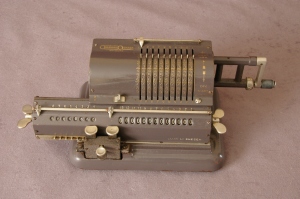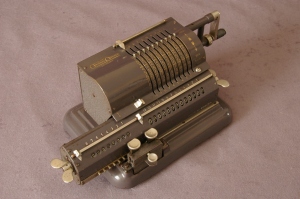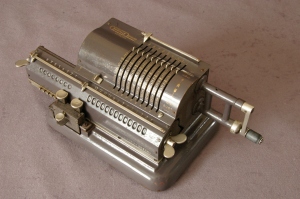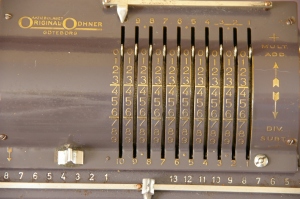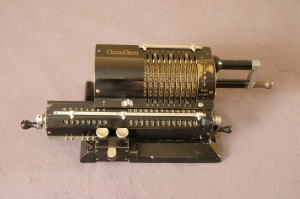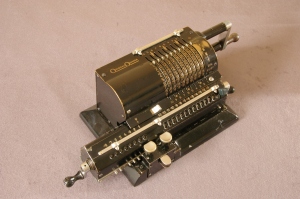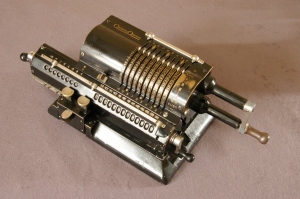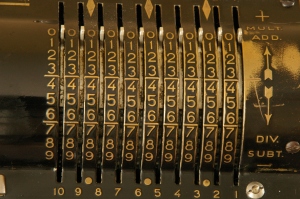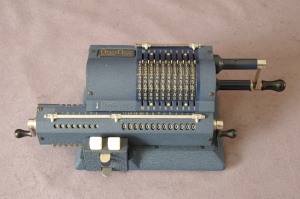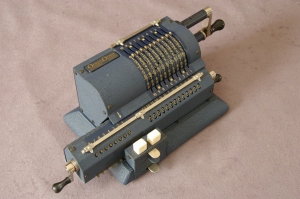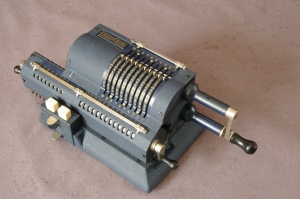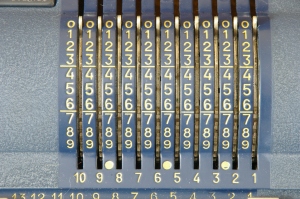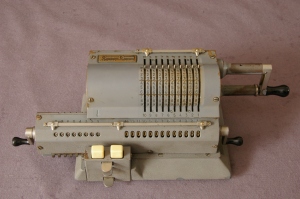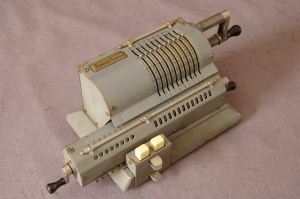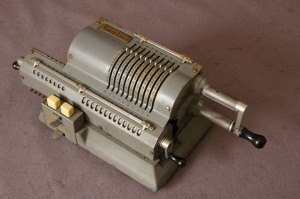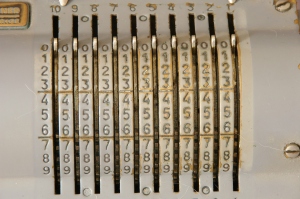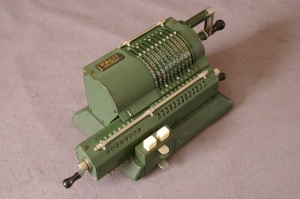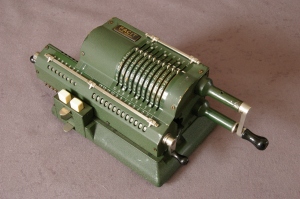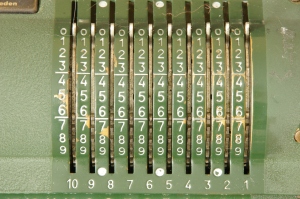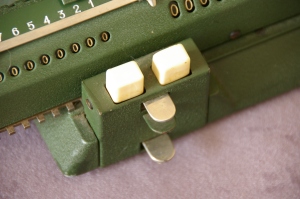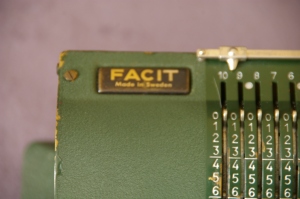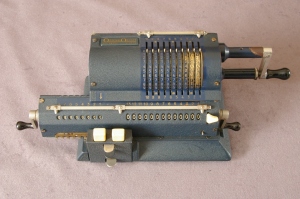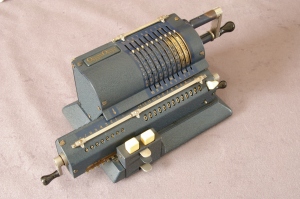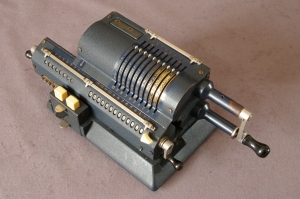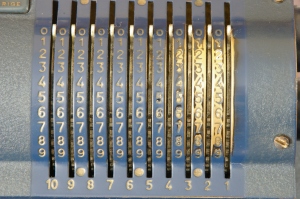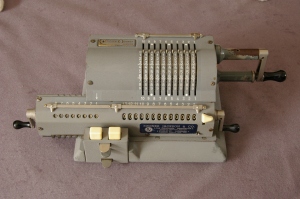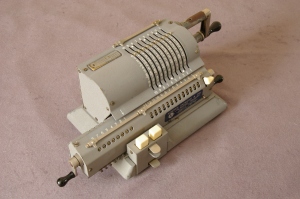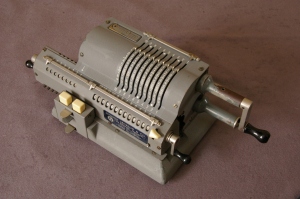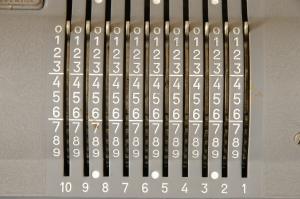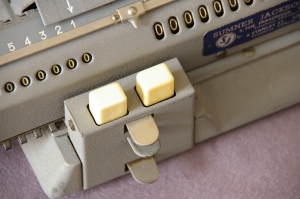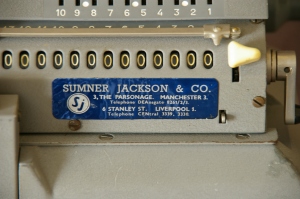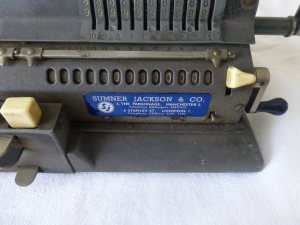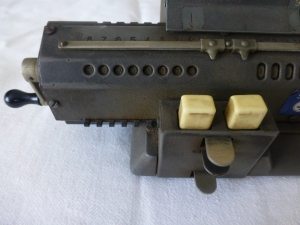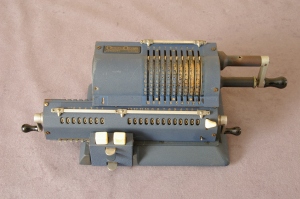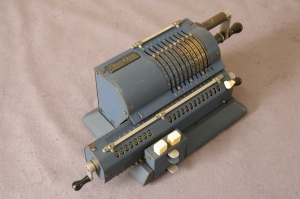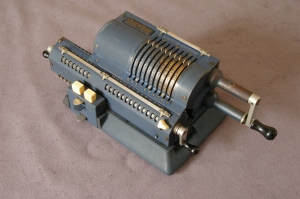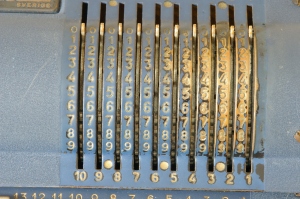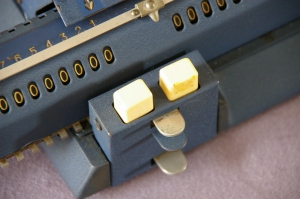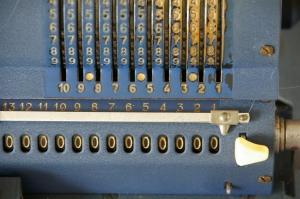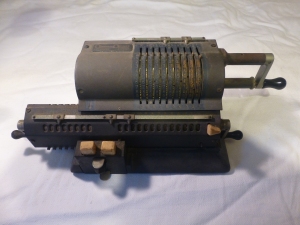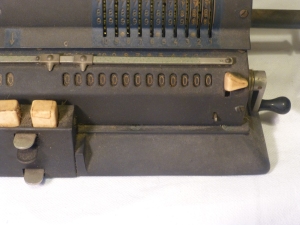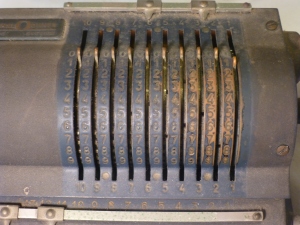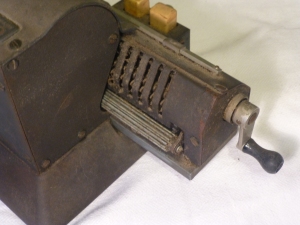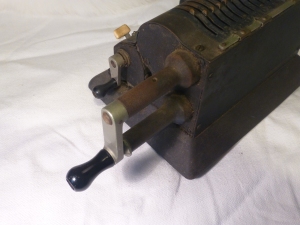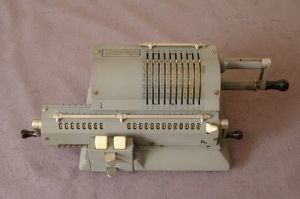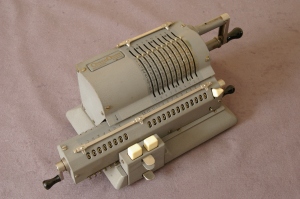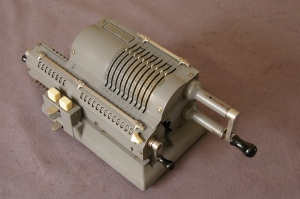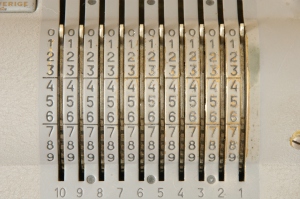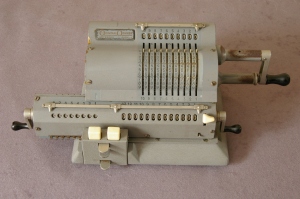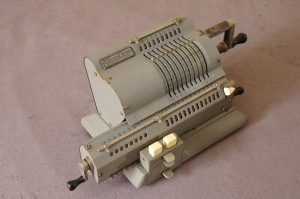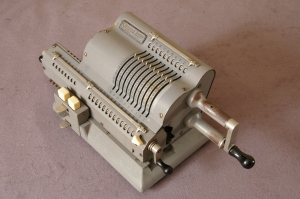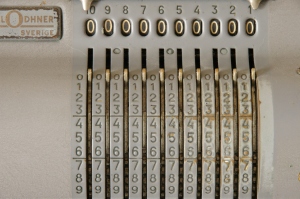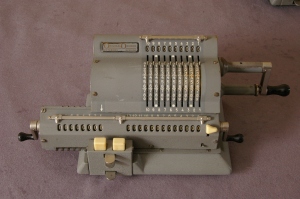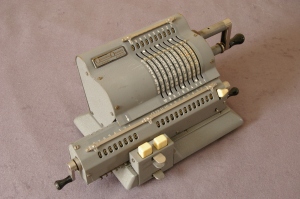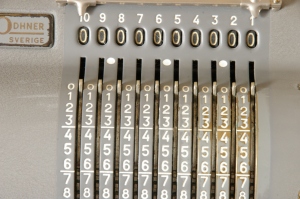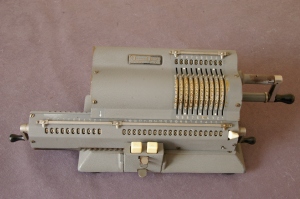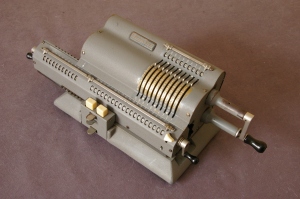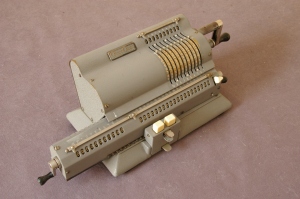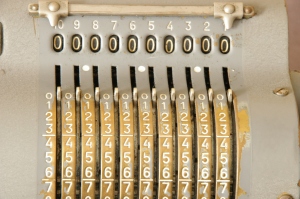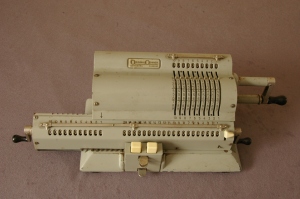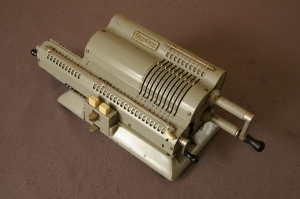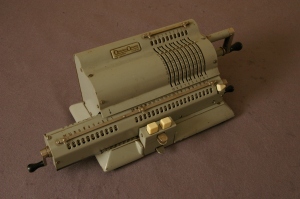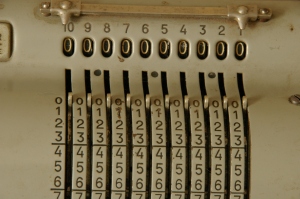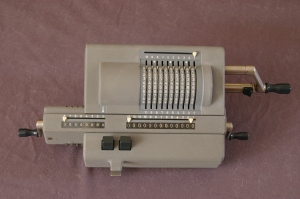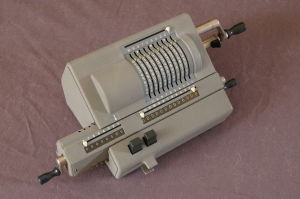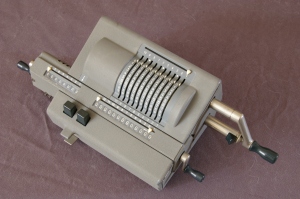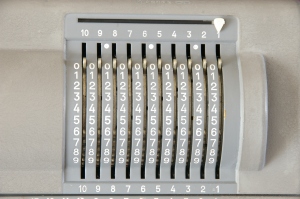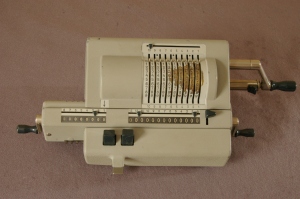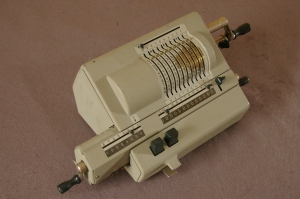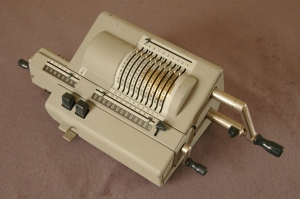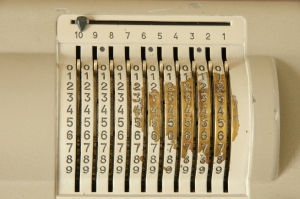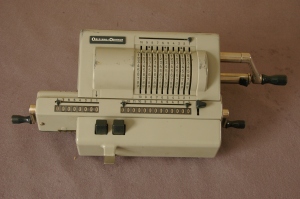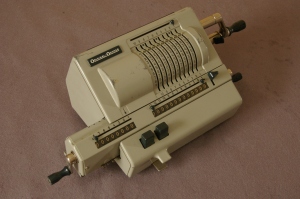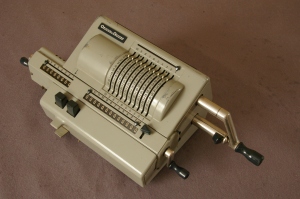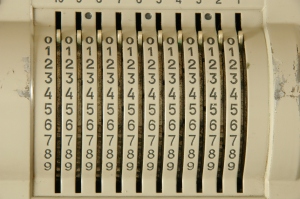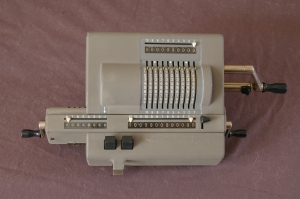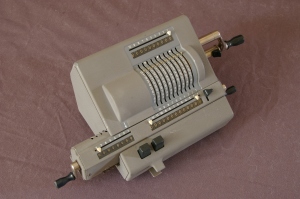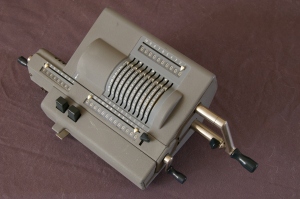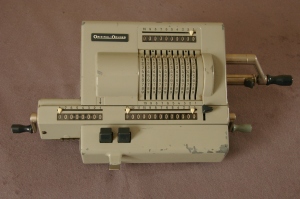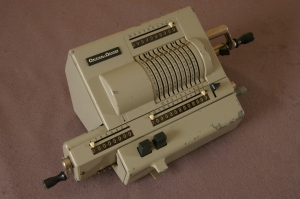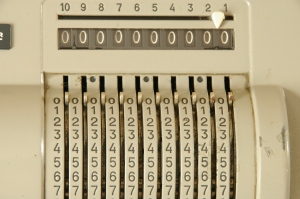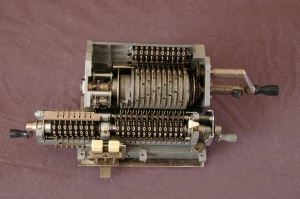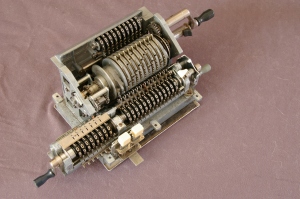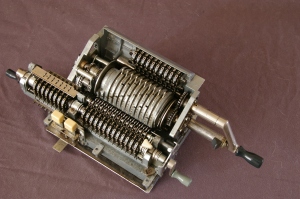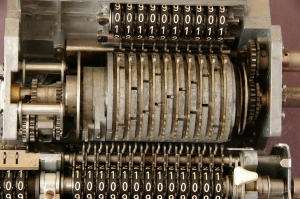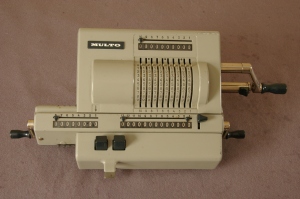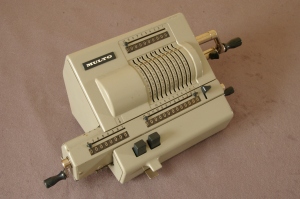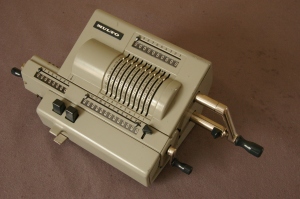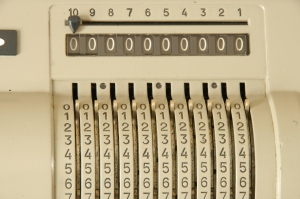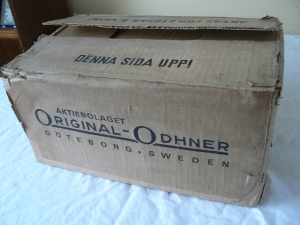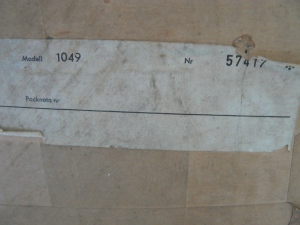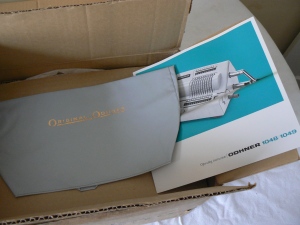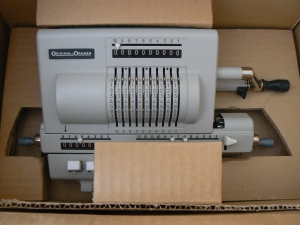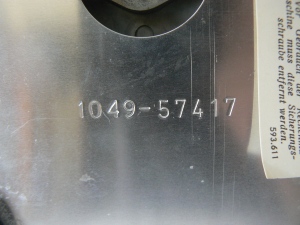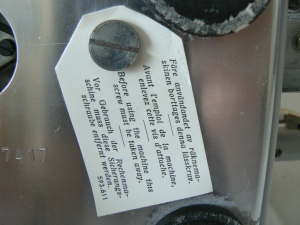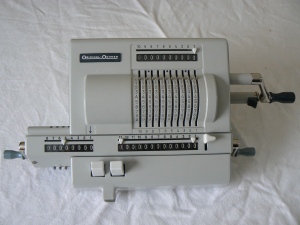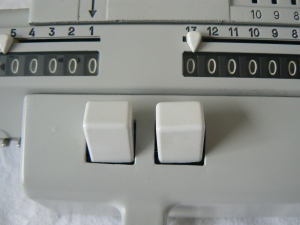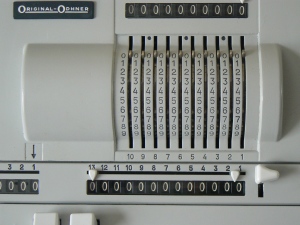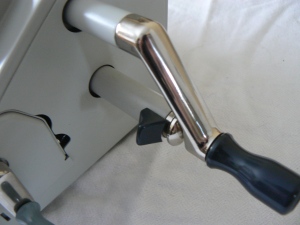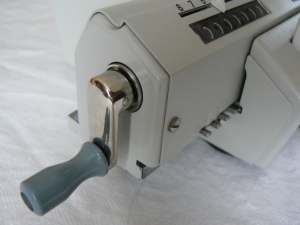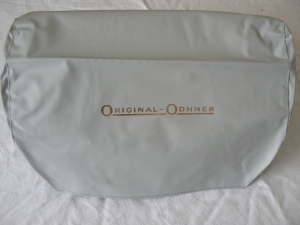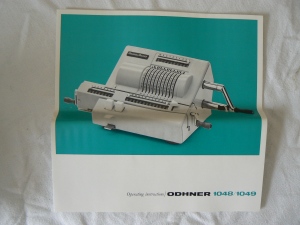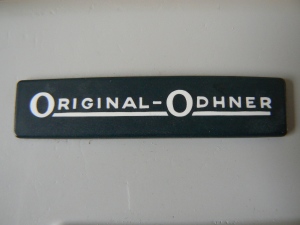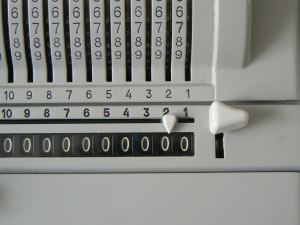Original-Odhner machines are classic examples of pinwheel machines – much imitated over the years, and rarely bettered. Originally based in pre-Soviet Russia, production moved to Sweden following the Russian revolution.
Odhner Model 7
Serial No. 63254
Date: 1922-1927
Capacity: 10x8x13
Price paid: £50
A basic model. At some point in its life, the main crank handle knob has been reduced in size, presumably because it sustained some damage.
The butterflies at the ends of the carriage are used to reset the revolution counter and result register. In later models, the butterflies were replaced with conventional cranks.
The machine, in common with later models, has a system of interlocks which ensure that:
- turns of the crank are completed in the same direction as they are started;
- the number in the input register can only be altered if the main crank is in the home position;
- the registers can only be cleared if the main crank is in the home position;
- the carriage can only be moved if the main crank is in the home position;
- the main crank can only be turned if the two butterflies are in the home position.
The machine is equipped with a quick clearing device whereby the input register can be cleared by moving the rectangular button to the left and holding it there while turning the main crank a quarter turn clockwise and then returning it to the home position. The button is attached to a clearing comb which blocks the slots at the bottom of the input register, engaging with the pinwheel setting levers and returning them to the zero position.
The two large round buttons on the front of the machine move the carriage a single step in the selected direction. When the small button below is depressed, the carriage can be moved freely between the end stops. Releasing the button then locks the carriage in the required position.
The machine is in working order, but jams occasionally. Stop press – upon further investigation, I found that the fifth wheel in the revolutions counter was stuck because the detent lever was jammed. Working this lever back and forth freed it up, and the machine now works perfectly.
Odhner Model 27
Serial No. 27-160158
Date: 1937-1940
Capacity: 10x8x13
Price paid (including postage): £50
This is essentially a Model 7 with the addition of a Back Transfer mechanism, which on this particular machine needs some attention. See the notes for the Model 127 below for a description of the Back Transfer facility.
Odhner Model 107 (in Blue)
Serial No. 107-603814
Machines built: 17500 approx.
Date: 1950
Capacity: 10x8x13
Price paid (including postage): £31
The Model 107 was introduced in 1948, finished in blue until 1951, when the colour was changed to grey.
The Model 107 is functionally very similar to the Model 7, which the Model 107 succeeded in 1948. The main differences are stylistic – the butterflies have been replaced with conventional cranks, and the metal carriage shift buttons have been replaced with white plastic ones.
The lower of the two projecting metal tabs operates the carriage release mechanism, which allows the carriage to be freely moved to the left or right within the limits of the end stops, while the tab immediately between the two carriage shift buttons engages the quick clearing comb, which is located inside the machine towards the rear, behind the main rotor. A quarter turn of the main crank, while keeping the tab depressed, resets the pinwheels to their zero positions.
The machine is in full working order.
Odhner Model 107 (in Grey)
Serial No. 107-609198
Date: 1952
Capacity: 10x8x13
Price paid (including postage): £24.20
Production of the grey version of the Model 107 began in 1950. This machine is functionally identical to the blue Model 107, but there are differences in detail. For example, the carriage covers are not interchangeable; nor is the main crank handle. There may be additional differences, but it seems that when Odhner were preparing for production of the other (later) models in the 100 series a decision was made to standardise some of the components across the product range.
Facit Model S
Serial No. 107F-626495
Date: 1952
Capacity 10x8x13
Price paid (including postage): £57.50
Is it an Odhner, or is it a Facit? Despite the Facit branding and colour, this is obviously an Odhner machine built by Odhner for Facit, and naturally enough belongs in this section of the site – but don’t be surprised if it is appears on the Facit page too.
This particular machine is in good working order. The price I paid, while on the high side for a Model 107 Odhner, was worth paying for this machine given its relative rarity in this guise.
Odhner Model 127 (in Blue)
Serial No. 127-652878
Machines built: 46000 approx.
Date: 1950
Capacity: 10x8x13
Price paid (including postage): £60
The Model 127 was introduced in 1948, finished in blue until 1950, when the colour was changed to grey. This machine is one of the later of the blue machines to be produced.
The main difference between the Model 127 and the Model 107 is that the Model 127 has a Back Transfer mechanism, whereby a number can be transferred from the result register to the input register for re-use. This is useful for chain calculations, and is particularly desirable on pin-set calculators of the Odhner pattern, where setting the numbers on the input register by directly moving the pinwheels by hand can be fiddly. This is not so much of an issue with key setting machines such as the Facit.
The Back Transfer on the Odhner Model 127 operates in the following manner (from the operator’s point of view, that is – if you want a detailed description of the inner workings of Odhner calculators, you’re better off looking here.)
- Clear the input register (by using the quick clearing mechanism);
- Move the switch to the right of the result register to its lower position;
- Clear the result register in the normal way with a clockwise turn of the crank on the right end of the carriage. The switch will return to its original position.
The number that was originally in the result register should now be in the input register.
If the Back Transfer switch is engaged in error, depressing the small lever immediately below it will return it to its original position.
The machine is in full working order.
Odhner Model 127 (in Grey)
Serial No. 127-676707
Date: 1952
Capacity: 10x8x13
Price paid (including postage): £22.49
Essentially the same as the blue version, with the same lack of interchangeable parts as described for the 107. It is of interest that in 1953 the numbers on the outer casing started to be picked out in white.
The machine is in full working order.
The machine was very dirty when I received it:
Odhner Model 127 (in Grey) – Before Cleaning
Odhner Model 129 (in Blue)
Serial No. 129-700135
Machines built: 4000 approx.
Date: 1950
Capacity: 10x8x13
Price paid (including postage): £29.75
Production of the Model 129 started at the very end of 1949 (only 5 machines were made that year!). As such, very few blue machines of this type were made.
To the untrained eye, there is little difference between the Model 129 and the Model 127. However, if you look carefully, you will notice that the numerals on the revolution counter are larger on the Model 129. This indicates the presence of ‘Tens Transmission’ or ‘Tens Carry’ in the revolution counter. This enables short cuts to be made in multiplication and division.
The machine is in full working order, but there hangs a tale……..
When I saw the machine offered on eBay in Germany, it was so filthy that it was difficult to tell whether it was blue – the fact that I was actively seeking a blue machine of this type helped. It was also described as “not completely working” – this was an understatement because:
- The entire auto-reversing mechanism for the revolution counter was missing – this accounted for the fact that the counter didn’t move!
- One of the carry sense levers was missing its detent pin – how is this even possible?
Fortunately, my “parts bin” contained the reversing mechanism from an Odhner 239 (which fitted), and a “dead” Model 137 (from which I harvested the required detent pin – as an aside, the detent pins changed from round to square when the 200 Series machines were introduced.
I took some pictures before I cleaned it up:
Odhner Model 129 (in Blue) – Before Cleaning
Odhner Model 129 (in Grey)
Serial No. 129-703437
Machines built: 4000 approx.
Date: 1952
Capacity: 10x8x13
Price paid (including postage): £62
Odhner Model 137
Serial No. 137-721696
Machines built: 5000 approx.
Date: 1952
Capacity: 10x8x13
Price paid (including postage): £35.51
Production of the Model 137 started in 1951, and ended in 1954, when it was replaced by the model 237. In a four year production run, only about 5000 machines of this type were made.
The Model 137 is identical to the Model 127 except for the addition of the Control Register – the row of windows above the input register showing the position of the pinwheels. While this is an advantage over the Model 127, the price differential was probably too high for the perceived benefit to be worth the extra cost, so the Model 137 did not sell well.
The machine is in full working order.
Odhner Model 139
Serial No. 139-752644
Machines built: 6000 approx.
Date: 1953
Capacity: 10x8x13
Price paid (including postage): £40.53
This is the fully featured model in the 100 Series, featuring Back Transfer, Tens Carry, and a Control Register. Production started in 1951, and a total of 6079 machines of this type were manufactured until production ceased in 1954, and the machine was replaced by the very popular Model 239.
The machine is in full working order.
Odhner Model 125
Serial No. 125-775893
Machines built: Not known
Date: 1955
Capacity: 10x11x20
Price paid (including postage): £32.63
The Model 125 is a long-carriage version of the Model 139, and as such would have been the top of the range. Production started at the end of 1952. It is uncertain when production of this model ceased – the rest of the 100 Series machines were replaced by the equivalent 200 Series machines in 1955, but the Model 125 has no 200 Series equivalent. Production probably continued after 1955, but for how long is not certain. What is known is that only 455 machines were produced up until the end of 1954.
The machine is in full working order.
Odhner Model 125 (Late Model)
Serial No. 125-786353
Date: 1956?
Capacity: 10x11x20
Price paid (including postage): £13.25
Another Model 125. The difference between this machine and the earlier version is that this machine is finished in a dull light grey gloss, whereas the earlier machine is finished in a darker crinkled grey. I’m not sure whether this applies to other models produced immediately before the introduction of the 200 Series.
The machine is in good working order. However, the main crank broke into two parts in transit and has been glued together with epoxy, so it’s really a display object rather than a working calculator.
Odhner Model 207
Serial No. 207-805604
Date: 1955 – 1967
Capacity: 10x8x13
Price paid (including postage): £62
This is an updated version of the Model 127. It looks different, but is functionally the same.
With the introduction of the 200 Series, Odhner calculators departed from the look which had characterised Odhner machines for most of the previous half century. Designed by Sigvard Bernadotte, a bold wedge shape replaced the barrel shape of previous models, the main crank handle was extended at an angle (presdumably to protect the knuckles), perspex windows now covered the number wheels, and the screws retaining the covers of the main body were now hidden (although not those retaining the covers of the carriage).
The button for engaging the quick clearing mechanism was moved to a position adjacent to the main crank. This means that operating the quick clearing mechanism is now a one-handed operation. In order to engage the quick clearing mechanism, the button is held to the left while initiating a clockwise quarter-turn with the main crank. Once the turn has been initiated, the button can be released.
I do not have any data for the relative production numbers of the different 200 Series models, but by far the most commonly seen is the Model 239, although I have seen (on eBay) all of the other 200 Series models (207, 227, 229, 237). Given the size of the relative production runs of the 100 Series models, one would expect the Model 227 to be the most popular. I’m assuming that Odhner priced their top of the range Model 239 competitively with regard to the other models in the 200 Series.
It is also difficult to precisely date 200 Series machines, but there is a break in the serial numbers – earlier machines have numbers in the 800000s, but later machines appear to start again from zero. As a rough guide, the lighter the shade of grey (they are all grey!), the later it is.
Odhner Model 227
Serial No. 227-832679
Date: 1955-1967
Capacity: 10x8x13
Price paid (including postage): £30
This is an updated version of the Model 127, and is functionally the same.
Odhner Model 229
Serial No. 229-944562
Date: 1955 -1967
Capacity: 10x8x13
Price paid: £35
Odhner Model 237
Serial No. 237-854154
Date: 1955 -1967
Capacity: 10x8x13
Price paid (including postage): £100
This particular machine was one that, once I’d identified the gap in my collection, was the most difficult to get. The relatively high purchase price reflects this.
The evidence strongly suggests that the 237 and 207 were only produced in small numbers and were quickly phased out of production. If pushed, I’d put the production date in 1955/56.
Odhner Model 239
Serial No. 239-893350
Date: Between 1955 and 1967
Capacity: 10x8x13
Price paid (including postage): £25
The Serial Number of this machine is a bit of a fiction. The first three machines I bought were Odhner Model 239s, and none of them worked perfectly, and one was completely jammed. With a LOT of help from John Wolff’s marvellous instructions here, I was able to get all three machines working perfectly, although with much swapping of internal parts.
The machine pictured is the first one I ever managed to rebuild, and it is, of course, in perfect working order. Sharp-eyed observers may have spotted that the resetting crank on the result register is a different colour from the others. This is because the original crank was broken in transit. I have acquired a few machines which are ‘good for parts’, usually as a result of inadequate packaging, and these are sometimes useful for spares, particularly resetting cranks and number wheels (where the paint is sometimes patchy). However, if the main crank breaks, there is little that can be done about it. I currently have an otherwise perfect Model 125 which is missing a main crank. I also have a two other machines with broken main cranks, but these machines have other serious faults rendering them beyond repair.
!! STOP PRESS !!
I managed to cobble a machine together out of my parts collection! I’ve long since run out of decimal markers, and the covers I have are a bit tatty, so I decided to produce a “demo” version without covers:
Multo Model 115
Serial No. 239-115-161923
Date: 1960s
Capacity: 10x8x13
Price paid (including postage): £20
The Multo Model 115 is an Odhner Model 239 with a Multo badge. The serial number gives it away!
Odhner Model 1049
Serial No. 1049-57417
Machines built: Unknown
Date: 1967-1970
Capacity: 10x8x13
Price paid: £82
In 1967, the production of Odhner calculators was rationalised to only two types, Models 1048 and 1049, which were equivalent to the 200 Series Models 229 and 239 respectively. Indeed, but for the changes in model number, the machines were identical to their predecessors.
It can be seen in retrospect that the pruning of the range of machines shows possible evidence that Odhner could see the writing on the wall as regards the future of mechanical calculators, given the advances in electronics taking place at the time.
This particular example of its type came in its original box, from which it had never been removed. It is in nearly mint condition, apart from some deterioration of the rubber feet – even boxed items can suffer with age.
Finally, a quick word about the 100 and 200 Series model numbers. The digits indicate various combinations of the presence of absence of tens carry in the revolutions counter, a control register, and a back transfer facility. If the second digit is a 2, it indicates that there is no control register, but that the back transfer facility is present, whereas a 3 indicates that both the control register and back transfer are present. A zero means that neither is present. If the third digit is a 7, it indicates that the revolutions counter doesn’t have tens carry, whereas a 9 shows that it does.

